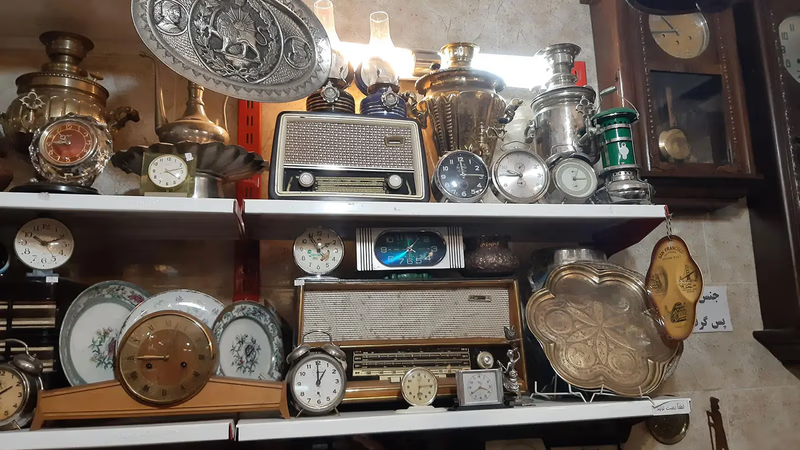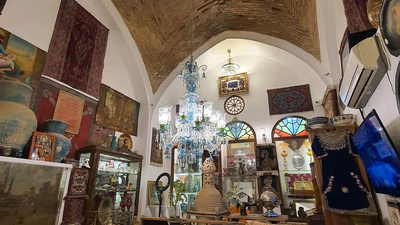
Discover exquisite Middle Eastern antiques showcasing rich culture.
Antiquities related to Islamic civilization and the culture of the people of the Middle East include a wide collection of objects and works of art that are related to the history, art, architecture and Islamic beliefs in the Middle East region. Every country has its own history and culture and therefore they offer antique goods related to that history and culture. Middle Eastern handicrafts include carpets, rugs, cashmere embroidery, Koran writing, mosaic work, tile work, traditional jewelry and shell work. These rich and beautiful crafts are produced throughout the Middle East and can be found as popular antiques in antique markets.
The region of West Asia and the Middle East includes countries such as Iran, Iraq, Lebanon, Egypt, Turkey , etc., which have a long and rich history and ancient civilization. These countries have been places that have had cultural, artistic and religious influences on other regions of the world. Therefore, the antiques of this region have a higher value as masterpieces of their ancient civilization. The antiques of West Asia and the Middle East are different from other regions of the world in many aspects. Some of these differences include specific styles, local cultural and religious designs and symbols, and the type of materials used in their construction.
The region of West Asia and the Middle East has a lot of cultural and ethnic diversity, and this diversity is also expressed in its antiques. Each country and region has specific examples of art, architecture, handicrafts and local decorations that are reflected in its antiques. Antique markets in West Asia and the Middle East are relatively active, and the trade and exchange of antiques in these regions is very strong. These markets are the best sources for finding special and unique handmade pieces in terms of the variety and number of antiques available.
Each country and region based on its history, culture, and civilization has unique antiques that represent the special and distinguishable aspects of that region. Therefore, to better understand the differences, it is recommended to study and examine the special antiques of each region and country. Some differences may change over time and cultural and historical influences on antiques may vary. Also, the type of antiques and antique goods is always changing and their variety may change depending on supply and demand, markets and other factors.
Islamic and Middle Eastern paintings include religious images, nature, angels, flags and geometric patterns. Wall paintings, paintings and textiles with Islamic motifs and designs are included in this collection. The pottery and ceramics of the Middle East include plates, bowls, teapots, mugs and various containers. These antique works include geometric designs, painted motifs and beautiful lines. In the Middle East region, several countries are known as the main sources of antique goods.
- Iran is one of the rich sources of ancient works and antiques of the Middle East. Antique goods related to Iran include hand-woven carpets, valuables (such as jewelry and precious stones), pottery and ceramics, wall paintings, inscriptions, architectural antiques (such as doors and windows), and ancient artifacts (such as Persepolis and Pasargad). Iran, with its history of several thousand years, is a rich source of pre-Islamic antiquities. Antique goods related to Iran include coins, gold and silver, old jewelry, pottery and ceramics, ancient works such as Persepolis and Pasargad, wall paintings and stone inscriptions.
- Türkiye is also one of the important sources of antiques in the Middle East. Antique goods related to Turkey include carpets, jewelry, antique brushes, pottery and ceramics, mirrors, vases, statues, and traditional dishes. Turkey is also a source of pre-Islamic antiques with its rich ancient history. Antique goods related to Turkey include ancient works such as Lycian works, Hellenistic and Roman works, statues, pottery and mirrors.
- Saudi Arabia also has antiquities related to Islamic civilization. Antiques associated with Saudi Arabia include historical weapons, traditional jewelry, Islamic paintings, ancient Qurans, rings, bracelets, and religious statues.
- Lebanon is one of the important antique centers in the Middle East. Antique goods associated with Lebanon include antique toothbrushes, pottery and ceramics, jewelry, antique clocks, statues, and mirrors. Lebanon has been a cultural center in the past and hosts many pre-Islamic antiquities. Antiquities associated with Lebanon include ancient artifacts such as temples, tombs, statues, pottery and ceramics, and wall paintings.
- Antique goods related to Iraq include sculptures and ancient artifacts such as Sumerian sculptures, Achaemenid artifacts, and Babylonian artifacts.
- Syria has a very rich ancient history and is a source of pre-Islamic antiquities. Antiquities associated with Syria include artifacts such as tomb assemblages, beds, pottery, petroglyphs, and wall paintings.
- As an old and ancient country, Israel is a source of important pre-Islamic antiquities. Antiquities associated with Israel include ancient artifacts such as tombs and Jewish temples, ancient coins, ancient jewelry, wall paintings, and pottery and ceramics.
- As a country with a rich ancient history, Afghanistan is a source of pre-Islamic antiquities. Antique goods associated with Afghanistan include ancient artifacts such as idols and statues, Achaemenid artifacts and the ancient domes of Bamiyan (which were unfortunately destroyed during the Taliban era).
- Pakistan has a rich ancient and cultural history and is a source of pre-Islamic antiquities. Antiquities associated with Pakistan include antiquities such as sculptures, pottery and ceramics, Hindu and Buddhist artefacts, and Achaemenid artefacts in parts of Pakistan.
- As one of the oldest civilizations in the world, Egypt is one of the most important sources of pre-Islamic antiquities in the Middle East. Antiquities associated with Egypt include artifacts such as pharaonic statues and figurines, scrolls and peripheral wall paintings, hieroglyphic works, and ancient water features such as the pyramids.
The rules and regulations for the supply and trade of antique goods may be different in each country. Islamic architecture in the Middle East includes mosques, palaces, mansions, historical buildings and beautiful gardens. Works such as domes, minarets, inscriptions, interior architecture and exteriors of buildings are among the antiques related to the Islamic architecture of the Middle East. Islamic and Middle Eastern jewelry includes necklaces, bracelets, rings, rings, and earrings. These jewelry are usually made using gold, silver and precious stones and are inspired by Islamic designs and motifs. Throughout the Middle East region, markets and museums are places where you can find such antiques.
The differences between the antiques of West Asia and the Middle East and other regions of the world are clear in their history, civilization, culture, and the type of goods and their occupation. Each region and country has its own history, culture and antique goods that are formed based on its resources and civilization. For example, the antiquities of West Asia and the Middle East include ancient civilizations such as Sumerians, Assyrians, Babylonians, Egyptian pharaohs, Persians, Jews, etc. As a result, a variety of antiquities can be seen, including coins, statues, stone tablets with conifer inscriptions, wall paintings, pottery and ceramics, and other ancient artefacts.




